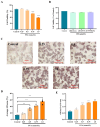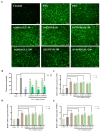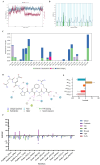Antioxidant Peptides from the Fruit Source of the Oil Crop Litsea cubeba Ameliorate FFA-Induced Oxidative Stress Injury: Based on Nrf2/Keap1 Pathway and Molecular Dynamics Simulations
- PMID: 40428488
- PMCID: PMC12111390
- DOI: 10.3390/foods14101707
Antioxidant Peptides from the Fruit Source of the Oil Crop Litsea cubeba Ameliorate FFA-Induced Oxidative Stress Injury: Based on Nrf2/Keap1 Pathway and Molecular Dynamics Simulations
Abstract
In this study, we systematically investigated the mechanisms of the antioxidation and anti-lipid accumulation effects of antioxidant peptides from Litsea cubeba on a free fatty acid (FFA)-induced NAFLD model of HepG2 cells. The NAFLD cell model was constructed by inducing the HepG2 hepatocellular carcinoma cell line with 0.5 mmol/L FFAs, and AQRDAGLL, QEGPFVR, and DVPPPRGPL were given to the culture to study their lipid-lowering and antioxidant activities on NAFLD cells. The lipid-lowering activities of the three antioxidant peptides were evaluated by Oil Red O staining and TG and TC content assays, and the results showed that all three peptides had strong ameliorating effects on FFA-induced lipid accumulation in NAFLD cells. The intracellular antioxidant protease (CAT, GSH, and SOD) activity levels and lipid peroxidation (MDA) content were measured and intracellular ROS levels were detected. The results showed that after intervention with the antioxidant peptides, the intracellular ROS levels in the NAFLD model cells were significantly reduced, the SOD and CAT activities were increased, the GSH content was elevated, and the MDA content was reduced, which indicated that AQRDAGLL, QEGPFVR, and DVPPPRGPL were able to inhibit the oxidative stress of the cells effectively and to achieve the effect of intervening in NAFLD. JC-1 fluorescence staining experiments showed that the mitochondrial membrane potential function of NAFLD cells was restored under the effect of the antioxidant peptides. Molecular dynamics simulations revealed that the main driving force between QEGPFVR and Keap1 protein was van der Waals forces, ΔG = -62.11 kcal/mol, which indicated that QEGPFVR was capable of spontaneously binding to Keap1 protein.
Keywords: Keap1/Nrf2 pathway; Litsea cubeba antioxidant peptides; ROS; molecular docking; molecular dynamics simulations.
Conflict of interest statement
There are no conflicts of interest to declare.
Figures










Similar articles
-
Bioactive proteins and antioxidant peptides from Litsea cubeba fruit meal: Preparation, characterization and ameliorating function on high-fat diet-induced NAFLD through regulating lipid metabolism, oxidative stress and inflammatory response.Int J Biol Macromol. 2024 Nov;280(Pt 4):136186. doi: 10.1016/j.ijbiomac.2024.136186. Epub 2024 Sep 30. Int J Biol Macromol. 2024. PMID: 39357720
-
Fucoidan ameliorates lipid accumulation, oxidative stress, and NF-κB-mediated inflammation by regulating the PI3K/AKT/Nrf2 signaling pathway in a free fatty acid-induced NAFLD spheroid model.Lipids Health Dis. 2025 Feb 17;24(1):55. doi: 10.1186/s12944-025-02483-z. Lipids Health Dis. 2025. PMID: 39962463 Free PMC article.
-
Antioxidant Peptides from Monkfish Swim Bladders: Ameliorating NAFLD In Vitro by Suppressing Lipid Accumulation and Oxidative Stress via Regulating AMPK/Nrf2 Pathway.Mar Drugs. 2023 Jun 16;21(6):360. doi: 10.3390/md21060360. Mar Drugs. 2023. PMID: 37367685 Free PMC article.
-
Gentiopicroside Ameliorates Oxidative Stress and Lipid Accumulation through Nuclear Factor Erythroid 2-Related Factor 2 Activation.Oxid Med Cell Longev. 2020 Jun 16;2020:2940746. doi: 10.1155/2020/2940746. eCollection 2020. Oxid Med Cell Longev. 2020. PMID: 32655764 Free PMC article.
-
Alleviating Effect of Lipid Phytochemicals in Seed Oil (Brassica napus L.) on Oxidative Stress Injury Induced by H2O2 in HepG2 Cells via Keap1/Nrf2/ARE Signaling Pathway.Nutrients. 2024 Aug 23;16(17):2820. doi: 10.3390/nu16172820. Nutrients. 2024. PMID: 39275137 Free PMC article.
References
-
- Ahmad T., Belwal T., Li L., Ramola S., Aadil R.M., Abdullah, Xu Y., Zisheng L. Utilization of wastewater from edible oil industry, turning waste into valuable products: A review. Trends Food Sci. Technol. 2020;99:21–33. doi: 10.1016/j.tifs.2020.02.017. - DOI
-
- Xu L., Wei Z., Guo B., Bai R., Liu J., Li Y., Sun W., Jiang X., Li X., Pi Y. Flaxseed Meal and Its Application in Animal Husbandry: A Review. Agriculture. 2022;12:2027. doi: 10.3390/agriculture12122027. - DOI
-
- Yong K.J., Wu T.Y. Second-generation bioenergy from oilseed crop residues: Recent technologies, techno-economic assessments and policies. Energy Convers. Manag. 2022;267:115869. doi: 10.1016/j.enconman.2022.115869. - DOI
-
- Kotecka-Majchrzak K., Sumara A., Fornal E., Montowska M. Oilseed proteins—Properties and application as a food ingredient. Trends Food Sci. Technol. 2020;106:160–170. doi: 10.1016/j.tifs.2020.10.004. - DOI
-
- Shao J., Zhang G., Fu J., Zhang B. Advancement of the preparation methods and biological activity of peptides from sesame oil byproducts: A review. Int. J. Food Prop. 2020;23:2189–2200. doi: 10.1080/10942912.2020.1849276. - DOI
Grants and funding
- 20203ABC28W016/The Major Science and Technology Research & Development Special Project
- 2020CXZX07/Special Research Project on Camphor Tree (KRPCT) of Jiangxi Forestry Department
- YC2023-B136/Jiangxi Province Graduate Innovation Special Fund Project
- 202310410006/College Students' Innovative Entrepreneurial Training Plan Program
LinkOut - more resources
Full Text Sources
Miscellaneous

